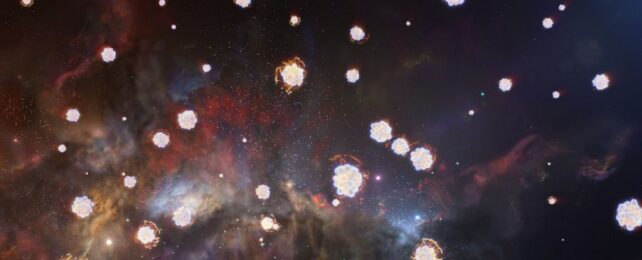Clouds of gas drifting through the early Universe have given astronomers a glimpse at what remains of the very first stars ever born.
Not the stars themselves; they are long gone, burning hot and fast before exploding in a blaze of supernova glory too distant for our instruments to detect. However, the material they leave behind in those explosions lays bare the products of the atomic fusion that took place in their cores.
"For the first time ever," says astronomer Andrea Saccardi of the Paris Observatory, "we were able to identify the chemical traces of the explosions of the first stars in very distant gas clouds."
According to our currently accepted cosmology, there was a time in the Universe's history when all was dark and grim. The Universe – a lot smaller back then, some 13.8 billion years ago – was filled with a hot, murky fog of ionized gas that prevented light from traveling through the Universe. Any photons would have simply scattered off free electrons.
Once the Universe cooled down sufficiently, the protons and electrons recombined into neutral helium and hydrogen. It wasn't until after the first stars and galaxies were born, their ultraviolet radiation reionizing the neutral hydrogen, that light could stream freely across the entire electromagnetic spectrum.
We think these first stars came along 13.7 to 13.5 billion years ago, but we've never actually seen one. We call them Population III stars, and they were probably very different from the stars we see around us today.
They could have been massive, which means they would have burnt out quickly, ending in supernova explosions that spewed their contents out into space, to be taken up in the next generation of star formation.
But the production of heavy elements requires stars. Population III stars were mostly hydrogen and helium because that's all there was in the Universe when they were born (plus minimal traces of lithium, the third lightest element).
But the nuclear factories in their cores fused the atoms of these elements to create heavier ones, like carbon, oxygen, and magnesium; these elements then spread into space when the star exploded.
Because the stars are long gone, we can't study them directly currently, although astronomers hold out hope that we may be able to one day. However, that doesn't mean all traces of them are gone.
"Primordial stars can be studied indirectly by detecting the chemical elements they dispersed in their environment after their death," says astrophysicist and cosmologist Stefania Salvadori of the University of Florence in Italy.
To look for the guts of primordial stars, Saccardi and his colleagues used the X-shooter instrument on the European Southern Observatory's Very Large Telescope to analyze the light of very bright, distant galaxies known as quasars.
As this light moves through space, sometimes it travels through clouds of material. This can change the light a little, making some parts of the spectrum brighter or dimmer as wavelengths are absorbed and re-emitted by elements in the clouds.
Scientists can carefully study these signatures in a spectrum and link them to specific elements. The researchers collected observations of 54 such clouds of material and looked for traces of the elements likely to be strewn through space by Population III stars, in combination with a low level of heavier elements such as iron.
They found the signature they were looking for in three clouds, dating to between the first 1 and 2 billion years or so after the Big Bang.
These three clouds had a high abundance of carbon and oxygen, with magnesium, and silicon-to-iron ratios that were in excellent agreement with ancient nearby stars with very little heavy element content.
In addition, the magnesium and silicon abundances are consistent with the low-energy supernovae expected of primordial stars.
The results suggest that, although we're yet to see Population III stars in the wild, it is possible to find their remnants. And, with powerful enough tools, we can probe these traces to learn more about the evolution of matter in the Universe, as stars change the elemental abundances of the stuff around us over time.
"Our discovery opens new avenues to indirectly study the nature of the first stars, fully complementing studies of stars in our galaxy," Salvadori says.
The research has been published in The Astrophysical Journal.
